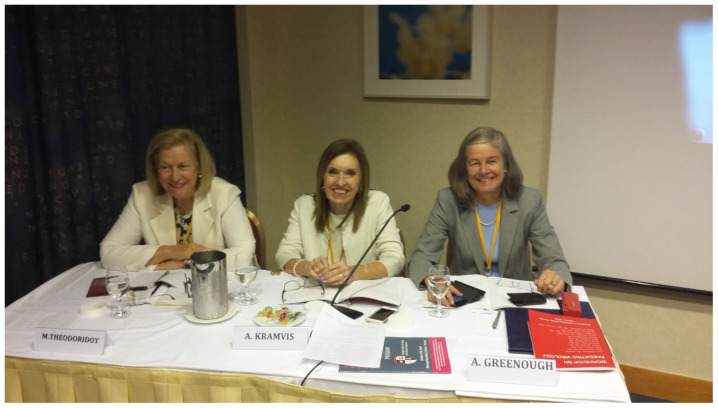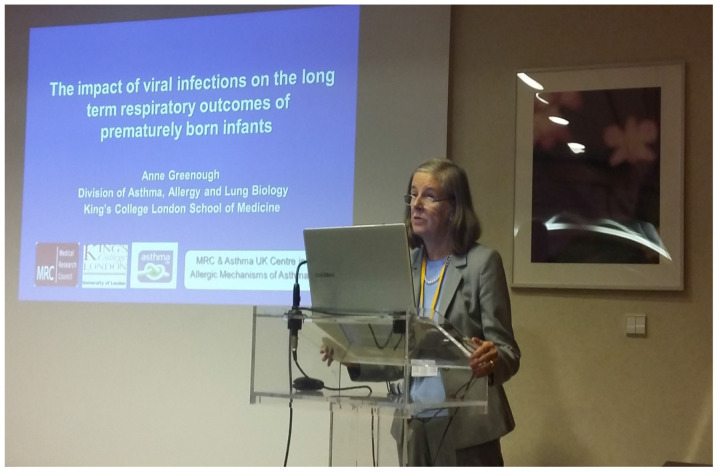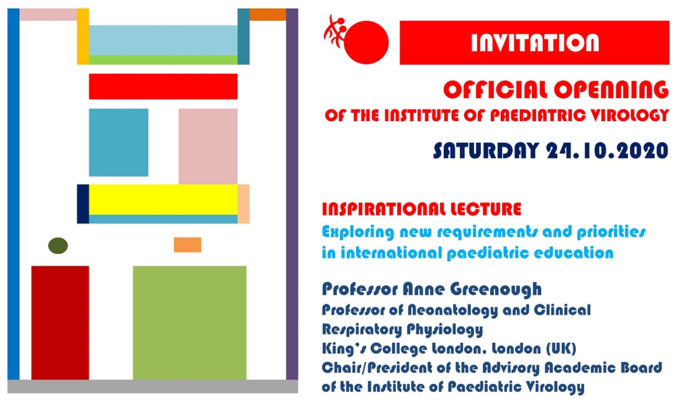I heard for the first time about Professor Anne Greenough, Professor of Neonatology and Clinical Respiratory Physiology at the King's College London in London in the United Kingdom (UK) and vice President of Science and Research at the Royal College of Paediatrics and Child Health (RCPCH), in 2005, in Liverpool, at the beginning of my paediatric and neonatal training. I studied, there, almost 14 years ago, at the Library of the Wirral University Teaching Hospital, her book on congenital, perinatal and neonatal infections (1), which was our ‘Bible’ on neonatal infections not only for me, but for all my colleagues in neonatology and paediatrics at the Wirral. Her second book on neonatal respiratory disorders with Professor Anthony Milner (2), which was published in 2003, was always my companion during my first job, a few months later, as a Senior House Officer (SHO) in paediatric accident and emergency (A&E) in Southport and six months later as a SHO in neonatology at the Wirral University Teaching Hospital.
The inspiration of her title, as ‘our Queen in neonatology’, referred to in our interview published in Experimental and Therapeutic Medicine (3), does not belong to me. During my presence in Douglas on the Isle of Man, in 2008, working at the local neonatal unit, I heard about her outstanding clinical talent in neonatology. My consultant, Dr Prakash Thiagarajan (4), was one of her students with a very promising career in London; his comments on her were more than enthusiastic: ‘She is excellent as a clinical scientist, as an academic teacher, as a human; she is our Queen in neonatology’. He was really proud of her, as well as of his clinical experience with her in London. Interestingly, with this experience, he managed to organise in Douglas one of the most modern neonatal units in the UK, which supports successfully the high percentages of births - even premature and high-risk births - performed on the Isle of Man, a Rhodes-shaped island in the UK, between Merseyside and Ireland (4).
In September 2009, I attended the European Respiratory Society (ERS) congress in Vienna, Austria, where I performed my oral presentation on under-water births and water aspiration syndrome (5); there, I had the chance to answer two questions by Professor Greenough, who initiated a very educational debate on under-water births. At the end of the session, during our discussion, I was really surprised and impressed that she had read our article with Dr Thiagarajan on under-water births (6), which had been just published in the Journal of Maternal and Fetal Neonatal Medicine. In summer 2015, I met her again in London, where I explained to her our proposal on paediatric virology and she promised to me that she will support our scientific attempt. Three months later, she chaired the first ‘workshop on paediatric virology’ performed as an official session of Professor Demetrios A. Spandidos's congress in Athens, Greece, and she gave one of the three plenary lectures of that meeting on long term outcomes of respiratory viral infections in premature neonates (7). Her lecture was one of the most interesting, inspirational, evidence-based lectures that I have ever attended (Figs. 1 and 2).
Figure 1.
Professor Maria Theodoridou, Professor of Paediatrics at the University of Athens School of Medicine (Greece) and Professor Anna Kramvis, Research Professor of Virology at the University of the Witwatersrand in Johannesburg (South Africa) co-chairing with Professor Anne Greenough the first ‘workshop on paediatric virology’ held in Athens, Greece, on October 10th, 2015.
Figure 2.
Professor Anne Greenough as plenary lecturer at the first ‘workshop on paediatric virology’ held in Athens, Greece, on October 10, 2015.
‘John came in London and he abducted me for this workshop’, she noted during the closing of the workshop. ‘It was like the Greek myth of the abduction of Europe’ she added. Interestingly, this myth is referred to the Cretan story of the abduction of Europe, the mother of King Minos of Crete by Zeus on the island of Crete. I do not know further details about this myth, except for the fact that Europe is very well represented on the logo of the University of Crete designed by Mrs. Aspasia Papadoperaki based on this myth. On my island, island of Euboea, the birth place of Dr George N. Papanicolaou, there is also a similar ancient Greek myth, which involves not Europe but Hera, not a bull but a bird, and not Crete, but the South of the island of Euboea. What I also know is that in modern times, in 2015, without any doubt, the ‘abduction’ of Professor Greenough in Athens gave birth, indeed, to the ‘workshops on paediatric virology’ (8-12). And she also gave birth to the new idea of the ‘rapidly increasing educational challenge’ of paediatric virology and its potential role as a separate paediatric subspecialty in the future (13). Two years later, on Saturday 7th October 2017, the ‘3rd workshop on paediatric virology’ (10), co-chaired by Professor Greenough, honored Nobel Laureate Professor of Virology Harald zur Hausen and with her support our workshop became indeed a ‘crossroad meeting’ between virologists and paediatricians (14). Our aim to bring together virology with paediatrics had been fulfilled!
To date, Professor Greenough, has received the ‘2015 Paediatric Virology Award’ and the ‘2017 George N. Papanicolaou Humanitarian Award’ for her outstanding contribution to paediatric virology and to the wealth, health and future of humanity, respectively. These awards are the highest honours by the Paediatric Virology Study Group (PVSG) bestowed upon selected world leading scientists in our field. The first award was handed over to her by Professor Demetrios A. Spandidos, Professor of Clinical Virology at the University of Crete School of Medicine (Greece), while the ‘2017 George N. Papanicolaou Humanitarian Award’ was offered to her by Dr Neda Voutsa-Perdiki (15), student of Dr George N. Papanicolaou, who attended his lab at the end of '50s and recently published her book about Dr Papanicolaou entitled ‘Dr George and Mache-Mary Papanicolaou - As I knew them’.
Professor Greenough is one of the leading experts in neonatology in the world with an outstanding contribution to paediatric knowledge; she is a great pioneer of modern neonatology (3). On behalf of the PVSG and the newly founded Institute of Paediatric Virology (IPV) based on the island of Euboea, Greece (16), we wish to thank Professor Greenough deeply for her support; this is a great honor for us. To date, she has trusted our scientific attempt with dignity and consistence. All this time, our responsibility to fulfill her high-level scientific standards is great; our gratitude to her is also great, indeed.
In the context of the forthcoming official opening of the Institute of Paediatric Virology Professor Anne Greenough's inspirational lecture will be entitled ‘Exploring new requirements and priorities in international paediatric education’ (Fig. 3).
Figure 3.
The invitation of Professor Anne Greenough's inspirational lecture in the context of the official opening of the Institute of Paediatric Virology based on the island of Euboea in Greece on October 24, 2020.
Acknowledgements
This article is published in the context of the foundation of the Institute of Paediatric Virology (IPV; https://paediatricvirology.org) based on the island of Euboea (Greece), under the auspices of the World Academy of Sciences (WAS) and the support of the Department of Clinical Virology of the University of Crete School of Medicine and the First Department of Paediatrics of the University of Athens School of Medicine. I would like to thank all the members of the IPV for their valuable comments and corrections.
Funding
No funding was received.
Availability of data and materials
Not applicable.
Author's contribution
INM contributed to the conception and design of this manuscript, wrote the original draft, edited and critically revised the manuscript, read and approved the final manuscript.
Ethics approval and consent to participate
Not applicable.
Patient consent for publication
Not applicable.
Competing interests
INM is Co-founder of the Institute of Paediatric Virology (IPV).
References
- 1.Greenough A, Osborne J, Sutherland S (eds) Congenital, perinatal, and neonatal infections. Churchill Livingstone, 1992. [Google Scholar]
- 2.Greenough A, Roberton NRC, Milner A. Neonatal respiratory disorders. Taylor & Francis, 1995. [Google Scholar]
- 3.Mammas IN, Spandidos DA. The educational challenge of Paediatric Virology: An interview with Professor of Neonatology Anne Greenough. Exp Ther Med. 2017;14:3332–3334. doi: 10.3892/etm.2017.5007. [DOI] [PMC free article] [PubMed] [Google Scholar]
- 4.Mammas IN, Spandidos DA. Neonatology, paediatrics and paediatric virology on a British island: An interview with neonatologist Dr Prakash Thiagarajan (Isle of Man) Exp Ther Med. 2018;16:2790–2794. doi: 10.3892/etm.2018.6544. [DOI] [PMC free article] [PubMed] [Google Scholar]
- 5.Mammas IN, Basha A, McCann P, Thiagarajan P. Underwater-birth and neonatal respiratory distress: a retrospective study In: Proceedings of the 19th European Respiratory Society Annual Congress (ERS 2009), Vienna, 2009. Eur Resp J. 2019;34(S524) [Google Scholar]
- 6.Mammas IN, Thiagarajan P. Water aspiration syndrome at birth - report of two cases. J Matern Fetal Neonatal Med. 2009;22:365–367. doi: 10.1080/14767050802556067. [DOI] [PubMed] [Google Scholar]
- 7.Greenough A, Drysdale S, Broughton S, Bont L. The impact of viral infections on the long-term outcomes of prematurely born infants. Int J Mol Med. 2015;36(S89) [Google Scholar]
- 8.Mammas IN, Greenough A, Theodoridou M, Kramvis A, Christaki I, Koutsaftiki C, Koutsaki M, Portaliou DM, Kostagianni G, Panagopoulou P, et al. Current views and advances on Paediatric Virology: An update for paediatric trainees. Exp Ther Med. 2016;11:6–14. doi: 10.3892/etm.2015.2890. [DOI] [PMC free article] [PubMed] [Google Scholar]
- 9.Mammas IN, Theodoridou M, Kramvis A, Thiagarajan P, Gardner S, Papaioannou G, Melidou A, Koutsaki M, Kostagianni G, Achtsidis V, et al. Paediatric Virology: A rapidly increasing educational challenge. Exp Ther Med. 2017;13:364–377. doi: 10.3892/etm.2016.3997. [DOI] [PMC free article] [PubMed] [Google Scholar]
- 10.Mammas IN, Greenough A, Theodoridou M, Kramvis A, Rusan M, Melidou A, Korovessi P, Papaioannou G, Papatheodoropoulou A, Koutsaftiki C, et al. Paediatric Virology and its interaction between basic science and clinical practice (Review) Int J Mol Med. 2018;41:1165–1176. doi: 10.3892/ijmm.2018.3364. [DOI] [PMC free article] [PubMed] [Google Scholar]
- 11.Mammas IN, Theodoridou M, Thiagarajan P, Melidou A, Papaioannou G, Korovessi P, Koutsaftiki C, Papatheodoropoulou A, Calachanis M, Dalianis T, et al. A paediatric influenza update 100 years after the Skyros island Spanish flu outbreak. Exp Ther Med. 2019;17:4327–4336. doi: 10.3892/etm.2019.7515. [DOI] [PMC free article] [PubMed] [Google Scholar]
- 12.Mammas IN, Dalianis T, Doukas SG, Zaravinos A, Achtsidis V, Thiagarajan P, Theodoridou M, Spandidos DA. Paediatric Virology and human papillomaviruses: An update. Exp Ther Med. 2019;17:4337–4343. doi: 10.3892/etm.2019.7516. [DOI] [PMC free article] [PubMed] [Google Scholar]
- 13.Mammas IN, Greenough A, Theodoridou M, Spandidos DA. Paediatric Virology: A new paediatric subspecialty? A proposal at the Workshop on Paediatric Virology, Athens, October 10, 2015. Exp Ther Med. 2016;11:3–5. doi: 10.3892/etm.2015.2889. [DOI] [PMC free article] [PubMed] [Google Scholar]
- 14.Mammas IN, Spandidos DA. Athens-based meeting to discuss the paediatric virology crossroad in October 2017. Acta Paediatr. 2017;14:3329–3331. doi: 10.1111/apa.13962. [DOI] [PubMed] [Google Scholar]
- 15.Mammas IN, Spandidos DA. George N: Papanicolaou (1883-1962), an exceptional human, scientist and academic teacher: An interview with Dr Neda Voutsa-Perdiki. Exp Ther Med. 2017;14:3346–3349. doi: 10.3892/etm.2017.5011. [DOI] [PMC free article] [PubMed] [Google Scholar]
- 16.Mammas IN, Greenough A, Theodoridou M, Spandidos DA. doi: 10.3892/etm.2020.9432. The foundation of the Institute of Paediatric Virology on the island of Euboea, Greece (Review). Exp Ther Med (In Press). [DOI] [PMC free article] [PubMed] [Google Scholar]
Associated Data
This section collects any data citations, data availability statements, or supplementary materials included in this article.
Data Availability Statement
Not applicable.





